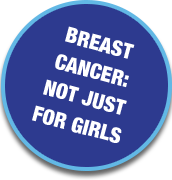Breast cancer is a condition that’s largely associated with women. However, this way of thinking is a little bit outdated. Whilst breast cancer in women is a lot more common, men can also develop the potentially fatal disease and, as such, greater awareness is required.
So, how common is a breast cancer diagnosis in males? Well, there is around one new case for every 100,000 men – adding to between 350-400 incidents in the UK each year. Worldwide, male breast cancer enters into the thousands.
But breast cancer isn’t on the male radar – it comes in as just the 17th most feared cancerous disease amongst men, in comparison with women, who rank it as second behind bowel cancer. And the stats continue to alarm. Despite the number of diagnoses in males, 24% of those males surveyed didn’t think it was even possible for them to be diagnosed with breast cancer in the first place.
For men, breast cancer usually starts in the tissue behind the nipples and a typical symptom will be that of a hard, painless lump. That said, the more likely cause of a lump will be because of gynaecomastia - a common non-cancerous condition where male breast tissues are enlarged. Visiting your GP will be the first step to identifying the cause of the lump.
Male breast cancer may also be identified by nipple problems, such as the nipple turning in on itself. Again, a healthcare professional will be able to assess your condition.












